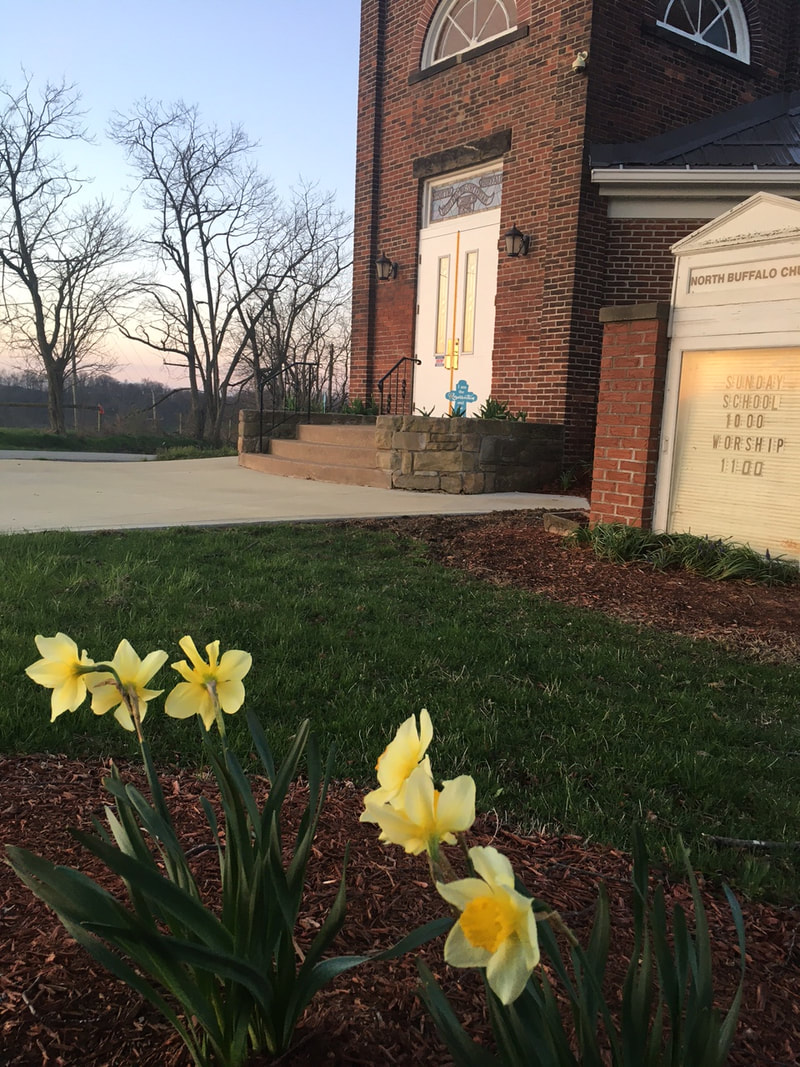|
Good morning!
Happy Easter!
When we meet together in person, we share our joys and concerns before we focus on our Sunday school lesson. Think about your needs and concerns right now, and if you like, you can share them in the comments.
Today’s lesson is on the resurrection account in Matthew 28:1-10. It is about how two women went to Jesus’s tomb in order to prepare his body. It is about the encounter they had with an angel there and with Jesus as they were returning to tell the disciples what they had seen and heard. The lesson is also about how Christ’s resurrection was and is the pivotal moment for the world and for each of us as Christ’s followers. The following prayer was written by Liz Curtis Higgs and posted on the website crosswalk.com:
Dear God, thank You for the resurrection of Your Son, Jesus. We want to celebrate Him every day of our lives. In a world that grows increasingly dark, help us hold up His light. Give us the courage to speak as boldly as Mary Magdalene did, and never be ashamed of proclaiming Your Good News. In Jesus’ Name, Amen.
This week's lesson is on Matthew 28:1-10.
Introduction
There are many events in the history of the world that have shaped the present. We think of the invention of written language and of William the Conqueror’s invasion of Normandy in 1066. As Americans, we remember events such as the surrender of the South that ended the Civil War, the Apollo 11 moon landing and the terrorist attacks of 9/11. These events changed the course of history and showed people at their best and their worst. However, there is one event that we can point to that actually did change everything. Today is Resurrection Sunday, when Christians around the world focus their attention on an event that happened on a Sunday morning 2,000 years ago — the resurrection of Jesus, the Christ. And the world has never been the same. Lesson context Matthew 28:1-10 is one of four resurrection narratives in the Gospels. All four paint the same picture in broad strokes. Even when they differ in details, the overarching truth of the events surrounding Jesus’s resurrection is the same. The differences, in fact, reveal Christ’s resurrection from different perspectives, assuring us that the stories are from different sources and not just one group.
I. The Empty Tomb (verses 1 to 7)
The Jewish sabbath is Saturday, and sunset marks the end of the day. Therefore, because of Jewish law, Sunday’s sunrise would have been the first opportunity for people to go to Jesus’s tomb. The body had been placed in the tomb quickly and without ceremony before sunset on Friday. A wealthy disciple named Joseph of Arimathea had provided the tomb and had placed the body in it with the help of Nicodemus. The women — Mary Magdalene and the other Mary, probably Mary the mother of James and Joseph — came to the tomb, hoping to continue preparation of the body with spices. Other gospels name additional women, but Matthew may focus on these two simply because they were prominent among the Jews, the group for whom he primarily wrote his gospel. Suddenly there is a violent earthquake as and angel comes down from heaven and rolls back the stone that seals Jesus’s tomb. Jewish leaders had feared Jesus’s disciples would steal the body and claim Jesus had risen from the dead. Therefore they had convinced Pilate to have the tomb sealed and to place guards around it. Question: Do displays of natural destruction cause you to fear God? Why or why not? Stones used for such purposes were usually disk-shaped and extremely heavy. However, the huge stone posed no problem for the might of the angel, who single-handedly rolled it away and sat on it. It is important to understand that Jesus had left the tomb before the stone was rolled away. The angel’s action was not to release Jesus but to reveal to the people that Jesus had risen. The angel’s appearance with clothes as white as snow clearly show him to be a supernatural being, and along with the earthquake and the angel’s actions, instill great fear in the guards. They shake and fall down like dead men. But the angel tells the women not to be afraid and that Jesus is risen, just as he said. Finally, it becomes clear that Jesus’s suffering and death was not a tragic accident. It was God’s plan all along, and it was how the creator had defeated death itself. The angel then invites the women to see the empty tomb and to go and tell his disciples that Jesus is risen from the dead. From the beginning, the church has elevated the role of women. They are the first witnesses to the resurrection, the first evangelists. This is another confirmation of the truth of the gospel. In that day, women were not considered reliable witnesses and were normally not allowed to bear witness in Jewish courts. Anyone inventing a story in the first century would not have made a group of women the lead witnesses. Their message to the disciples was not simply to report that Jesus’s body was gone. It was to report the wonderful message that Jesus has risen from the dead! And from that point on, the resurrection of Jesus would be the heart of the church’s proclamation. Question: How does your belief in the resurrection of Christ influence your daily life? The angel offered one final message for the women to give the disciples. The risen Jesus is going to Galilee, and the disciples can see him there. Galilee was the place where Jesus’s ministry began and the place where most of his ministry took place. Earlier in this gospel, Jesus had told them he would go before them into Galilee after he had risen. Now they understand that Jesus’s death was always a part of the plan.
II. The Risen Lord (verses 8 to 10)
We can imagine the rush of emotions that the women were feeling at this moment. In obedience, they hurry away from the tomb, filled with fear over what they had just seen but also with joy over the prospect of seeing their friend and Lord again and telling the disciples the good news. They run to complete their mission. Yet before they can reach the disciples, suddenly Jesus meets them on the way and greets them. The lesson points out that the word “Greetings!” can also be translated “Rejoice!” Readers can hear an echo of Jesus’s birth narrative in these words. In Matthew, the magi are overjoyed when they see the star indicating Jesus’s birth. And in Luke, the angels bring the shepherds “good news that will cause great joy for all the people.” Overjoyed, the women bow in worship before him and grasp his feet. This shows that they now recognize him as more than a teacher and friend. Throughout the Bible, it is clear that people are to worship God alone. Angels and apostles always reject worship from people who see them as more than they are. The fact that they grasp ahold of Jesus’s feet also shows that he is not ghost or a hallucination but that Jesus has been raised bodily. Jesus repeats and reinforces the angel’s message to the disciples to go to Galilee, where they will see him. However, instead of calling them disciples, Jesus calls them his brothers. It seems that Jesus spent at least seven days in Jerusalem before going to Galilee, where he spent some time teaching his disciples intensely about what they had experienced and what they should do. Galilee had many Gentile inhabitants as well as Jews, which is why Matthew calls it (in 4:15) “Galilee of the Gentiles.” It is fitting that Jesus would light his mission of salvation from there into all nations.
Conclusion
At the center of Christian faith is the affirmation that Jesus rose from the dead. This is the testimony of women who saw the empty tomb and who encountered the resurrected Jesus. We can trust their words, and we can live in the light of the message they were given. Believers have a new start and new life in Christ. We need not fear the grave. The resurrection of Jesus has changed everything, and we have been entrusted with that message. Because we are released from the fear of death, we are free to live for God. The faithful life requires much of us, but all that we do begins with the joy and awe of Jesus’s resurrection. Jesus’s resurrection demonstrates that the kingdom of God has broken into history. Its final consummation will come at the return of Christ. Believers may be confident that, when Christ returns, the Father will bring with Christ the dead in Christ who also had submitted and entrusted themselves to the Father. May our lives reflect God’s kingdom presence on earth in anticipation of the day we will experience it fully with him. Prayer We praise you, our Father, because you sent your Son, Jesus, to die for our sins. We praise you because you raised him from the dead and you will raise us to eternal life. In Jesus’s name we pray. Amen.
Benediction
This week's benediction is from the Good News Translation.
Next week's lesson will be on John 8:31-38.
0 Comments
Leave a Reply. |
AuthorWe are a small, rural Presbyterian church in southwestern Pennsylvania. Archives
July 2024
Categories
All
|



 RSS Feed
RSS Feed